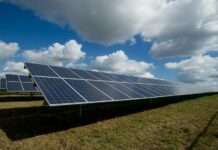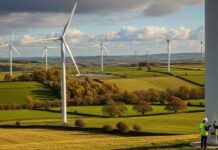A park is a place that’s been set aside for recreational purposes. Its outstanding beauty is one of the primary reasons it has been put aside. Most public parks have street lighting, while swimming pools have others like the aqua ones. Thus, it’s essential to have an effective energy management system to manage them.
An energy management system involves tracking how energy is consumed to ensure that you maximize its use to the fullest. The benefit of having an effective system is that you’ll be able to reap positive social and financial outcomes.
Moreover, you’ll be able to reduce pollution, energy use, and carbon footprint. Thus, you’ll be more energy efficient and provide the best services to your park’s visitors in the long run. One way to ensure energy efficiency is to use solar panels.
This will help the visitors enjoy the benefits of solar street lighting, which is something that almost everyone desires to find any time they visit a park, especially in the evening. Adequate lighting is crucial since it helps provide safety for individuals during the night. If you’re interested in knowing how energy management in parks is done, here’s a brief guide:
-
Pick Out What Consumes Energy
As the energy manager, you’d want to establish the things that consume energy the most in your park. Before doing this, it’s essential first to identify the energy sources the park uses, whether they will be artificial, like electricity, or natural. Once you’ve done that, consider what’s utilizing these energy sources. Some of these things may include:
- A chairoplane
- Street Lights
- Irrigation Systems
Knowing these areas will play a key role in enabling you to assess better how the energy is used. You may have incorporated the use of solar panels in your park to help reduce electricity usage, but then again, you’re supposed to be accountable for everything regardless.
The reason is that chances are high that these items, propelled by natural energy sources, may not be 100% dependent on them. They may still be using other sources. Therefore, ensure that you don’t leave out anything to help you have a seamless monitoring process.
-
Check The Utility Bill
As you use energy, especially if it’s electric, you need to pay for the amount you’ve used. Before paying, you can access the bill to see how much energy has been used within a specified period- a week, a month, or a year. To get this data, you can partner with an organization that has specialized in giving utility data services to get a clear and detailed report of the total amount and usage of your energy usage.
-
Do A Thorough Analysis
Once you’ve figured out the amount you’ve used for a particular period, you can compare it with the last utility bill you received (the previous period). This will help you determine whether the bill is too high or low and which is better. After you’ve made a comparison, and you’ve, for instance, found out that the bill is much higher than you expected, then you can get into the details of what exactly has contributed to the escalation.
You’ll be able to know the systems that are using the most energy and possibly try to answer the question of why. After you’re done doing that, it’s good to jot down what you’ve found out, including the quantity of energy the systems have used. Once you’re through, you can proceed to the next step.

-
Figure Out How To Minimize The Costs
As an energy manager, your aim should be to reduce energy costs as much as possible. You’d want to know the exact day you speculate excess energy was used that brought about the current huge bill and try to understand or remember how that happened.
The reason may be that a famous artist used your park as a venue to hold a concert and used your sockets to connect the musical instruments. If the event took a whole day, then chances are high that the bill will escalate. So, to avoid getting yourself in this and other situations, it would be best to use tactics to help reduce the energy costs in your park. Examples of how you can do this include:
- Charging for any mega event like a concert or rally to help offset the enormous bill you’ll probably get at the end of the period.
- Ensuring that the streetlights are off during the day.
- Making sure that no systems are running when they’re not supposed to.
- Replacing machinery like outdated irrigation systems that use excess energy with new ones. These systems help maintain the greenness of the grass in the park.
- Making sure you employ strategies like ozone sterilization to enable your pool to be eco-friendly.
- Using a pool cover to reduce the amount being lost through evaporation.
- Using energy-efficient bulbs like a light-emitting diode (LED) because of their durability and low energy requirement.
- Trying energy-efficient pool products like filters.
- Installing solid fences and walls to act as windbreaks to prevent pool evaporation.
-
Start Tracking The Progress
After taking any of the above actions to correct the high energy usage, you’d want to track progress and determine whether the energy usage has improved. If you find that it’s getting better and you’re using way less, you should continue using the strategy you’ve opted for.
On the other hand, if you’ve realized that there is little or no improvement, try to substitute electricity with another renewable energy source like the solar panel. This option is not only good for lighting but also for your pool, chairoplane, and all other systems that need energy.
Below are some of the reasons why incorporating solar usage is important:
- You’ll have a lower electricity bill.
- It reduces the amount of energy that you use.
- You’ll be able to contribute to environmental sustainability by reducing the carbon emitted to the environment.
- More people will be interested in hanging out at your park.
Ideally, the corrective measure you use should help reduce the overall energy costs you incur is critical.
Conclusion
Energy management in parks involves incorporating strategies to reduce energy usage and minimize utility costs. To do it successfully, you must first identify the systems in your park that use your chosen energy source. After that, consider looking at the utility bill and comparing it to the one from the previous period. Once you’ve confirmed and realized that the bills are too high, try and minimize costs.
You can use solar energy to help you achieve energy efficiency. As long as you’re doing proper energy management in your park, chances are high that you’ll be able to achieve global sustainability goals like reducing pollution. Moreover, many people would be interested in visiting the park. Try using this energy management guide today to your advantage!


































